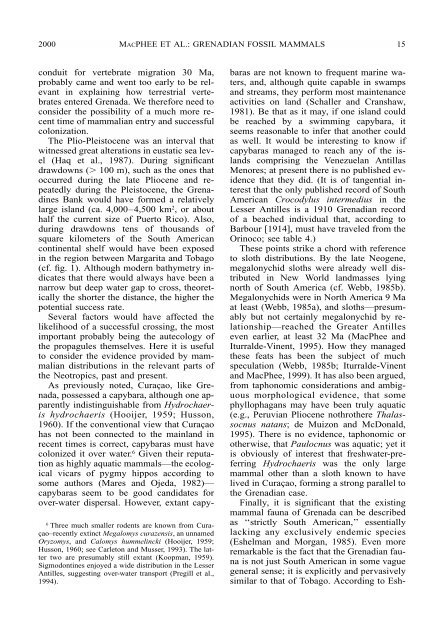Late Cenozoic Land Mammals from Grenada, Lesser Antilles Island ...
Late Cenozoic Land Mammals from Grenada, Lesser Antilles Island ...
Late Cenozoic Land Mammals from Grenada, Lesser Antilles Island ...
You also want an ePaper? Increase the reach of your titles
YUMPU automatically turns print PDFs into web optimized ePapers that Google loves.
2000 MACPHEE ET AL.: GRENADIAN FOSSIL MAMMALS<br />
15<br />
conduit for vertebrate migration 30 Ma,<br />
probably came and went too early to be relevant<br />
in explaining how terrestrial vertebrates<br />
entered <strong>Grenada</strong>. We therefore need to<br />
consider the possibility of a much more recent<br />
time of mammalian entry and successful<br />
colonization.<br />
The Plio-Pleistocene was an interval that<br />
witnessed great alterations in eustatic sea level<br />
(Haq et al., 1987). During significant<br />
drawdowns ( 100 m), such as the ones that<br />
occurred during the late Pliocene and repeatedly<br />
during the Pleistocene, the Grenadines<br />
Bank would have formed a relatively<br />
large island (ca. 4,000–4,500 km 2 , or about<br />
half the current size of Puerto Rico). Also,<br />
during drawdowns tens of thousands of<br />
square kilometers of the South American<br />
continental shelf would have been exposed<br />
in the region between Margarita and Tobago<br />
(cf. fig. 1). Although modern bathymetry indicates<br />
that there would always have been a<br />
narrow but deep water gap to cross, theoretically<br />
the shorter the distance, the higher the<br />
potential success rate.<br />
Several factors would have affected the<br />
likelihood of a successful crossing, the most<br />
important probably being the autecology of<br />
the propagules themselves. Here it is useful<br />
to consider the evidence provided by mammalian<br />
distributions in the relevant parts of<br />
the Neotropics, past and present.<br />
As previously noted, Curaçao, like <strong>Grenada</strong>,<br />
possessed a capybara, although one apparently<br />
indistinguishable <strong>from</strong> Hydrochaeris<br />
hydrochaeris (Hooijer, 1959; Husson,<br />
1960). If the conventional view that Curaçao<br />
has not been connected to the mainland in<br />
recent times is correct, capybaras must have<br />
colonized it over water. 6 Given their reputation<br />
as highly aquatic mammals—the ecological<br />
vicars of pygmy hippos according to<br />
some authors (Mares and Ojeda, 1982)—<br />
capybaras seem to be good candidates for<br />
over-water dispersal. However, extant capy-<br />
6<br />
Three much smaller rodents are known <strong>from</strong> Curaçao–recently<br />
extinct Megalomys curazensis, an unnamed<br />
Oryzomys, and Calomys hummelincki (Hooijer, 1959;<br />
Husson, 1960; see Carleton and Musser, 1993). The latter<br />
two are presumably still extant (Koopman, 1959).<br />
Sigmodontines enjoyed a wide distribution in the <strong>Lesser</strong><br />
<strong>Antilles</strong>, suggesting over-water transport (Pregill et al.,<br />
1994).<br />
baras are not known to frequent marine waters,<br />
and, although quite capable in swamps<br />
and streams, they perform most maintenance<br />
activities on land (Schaller and Cranshaw,<br />
1981). Be that as it may, if one island could<br />
be reached by a swimming capybara, it<br />
seems reasonable to infer that another could<br />
as well. It would be interesting to know if<br />
capybaras managed to reach any of the islands<br />
comprising the Venezuelan Antillas<br />
Menores; at present there is no published evidence<br />
that they did. (It is of tangential interest<br />
that the only published record of South<br />
American Crocodylus intermedius in the<br />
<strong>Lesser</strong> <strong>Antilles</strong> is a 1910 Grenadian record<br />
of a beached individual that, according to<br />
Barbour [1914], must have traveled <strong>from</strong> the<br />
Orinoco; see table 4.)<br />
These points strike a chord with reference<br />
to sloth distributions. By the late Neogene,<br />
megalonychid sloths were already well distributed<br />
in New World landmasses lying<br />
north of South America (cf. Webb, 1985b).<br />
Megalonychids were in North America 9 Ma<br />
at least (Webb, 1985a), and sloths—presumably<br />
but not certainly megalonychid by relationship—reached<br />
the Greater <strong>Antilles</strong><br />
even earlier, at least 32 Ma (MacPhee and<br />
Iturralde-Vinent, 1995). How they managed<br />
these feats has been the subject of much<br />
speculation (Webb, 1985b; Iturralde-Vinent<br />
and MacPhee, 1999). It has also been argued,<br />
<strong>from</strong> taphonomic considerations and ambiguous<br />
morphological evidence, that some<br />
phyllophagans may have been truly aquatic<br />
(e.g., Peruvian Pliocene nothrothere Thalassocnus<br />
natans; de Muizon and McDonald,<br />
1995). There is no evidence, taphonomic or<br />
otherwise, that Paulocnus was aquatic; yet it<br />
is obviously of interest that freshwater-preferring<br />
Hydrochaeris was the only large<br />
mammal other than a sloth known to have<br />
lived in Curaçao, forming a strong parallel to<br />
the Grenadian case.<br />
Finally, it is significant that the existing<br />
mammal fauna of <strong>Grenada</strong> can be described<br />
as ‘‘strictly South American,’’ essentially<br />
lacking any exclusively endemic species<br />
(Eshelman and Morgan, 1985). Even more<br />
remarkable is the fact that the Grenadian fauna<br />
is not just South American in some vague<br />
general sense; it is explicitly and pervasively<br />
similar to that of Tobago. According to Esh-
















